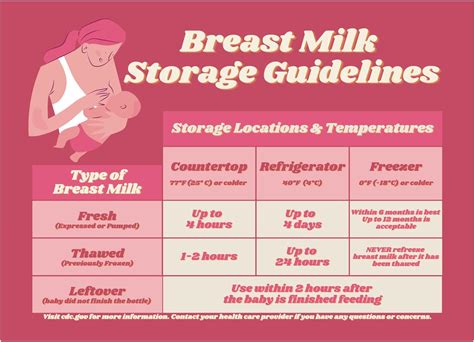Intro
Learn expert 5 Breast Milk Storage Tips for safe and hygienic preservation, including freezing, thawing, and labeling, to maintain nutritional value and convenience for breastfeeding mothers.
Breast milk is a precious gift for newborns, providing them with essential nutrients and antibodies that help them grow strong and healthy. However, expressing and storing breast milk can be a daunting task for many mothers, especially those who are new to breastfeeding. Proper storage and handling of breast milk are crucial to maintain its quality and safety for consumption. In this article, we will delve into the world of breast milk storage, exploring the best practices and tips to help mothers store their breast milk safely and effectively.
Breast milk storage is an essential aspect of breastfeeding, particularly for working mothers or those who need to express milk for their babies when they are not around. With the right storage techniques, mothers can ensure that their breast milk remains fresh and nutritious for their babies, even when they are not physically present. Moreover, proper storage can also help to reduce waste and make the most of the expressed milk. Whether you are a new mother or an experienced one, understanding the basics of breast milk storage is vital to provide your baby with the best possible nutrition.
The importance of breast milk storage cannot be overstated, as it directly affects the health and well-being of the baby. Improper storage can lead to contamination, spoilage, or degradation of the milk's nutritional properties, which can be detrimental to the baby's health. On the other hand, proper storage can help to preserve the milk's quality, ensuring that it remains a safe and nutritious food source for the baby. As we explore the world of breast milk storage, we will discuss the best practices, tips, and techniques to help mothers store their breast milk safely and effectively.
Understanding Breast Milk Storage Basics

Container Options
When it comes to storing breast milk, the type of container used is crucial. Glass bottles are a popular choice due to their non-toxic and non-reactive properties, which help to preserve the milk's nutritional properties. Plastic bottles, on the other hand, are lightweight and convenient but may contain BPA or other chemicals that can leach into the milk. Breast milk bags are another option, offering a convenient and space-saving way to store expressed milk. These bags are typically made from food-grade materials and are designed specifically for breast milk storage.Labeling and Dating

Storage Locations
Breast milk can be stored in various locations, including the refrigerator, freezer, or even at room temperature for short periods. The storage location depends on the intended use of the milk and the duration of storage. For example, breast milk can be stored in the refrigerator for up to 3-5 days, while frozen breast milk can be stored for up to 6-12 months. Room temperature storage is generally not recommended, as it can lead to bacterial growth and contamination.Storage Tips and Techniques

- Always use clean and sterile equipment when expressing and storing breast milk.
- Store breast milk in small, airtight containers to prevent contamination and spoilage.
- Label and date each container with the date and time of expression, as well as the amount of milk stored.
- Store breast milk in the refrigerator or freezer, depending on the intended use and duration of storage.
- Avoid mixing breast milk from different expression sessions, as this can lead to contamination and spoilage.
Freezer Storage
Freezer storage is an excellent option for breast milk, as it can be stored for up to 6-12 months. When freezing breast milk, it's essential to use freezer-safe containers or bags to prevent the milk from becoming damaged or contaminated. Frozen breast milk can be thawed overnight in the refrigerator or quickly thawed by submerging the container in warm water. Once thawed, breast milk should be used within 24 hours.Thawing and Reheating

- Thaw frozen breast milk overnight in the refrigerator or quickly thaw it by submerging the container in warm water.
- Once thawed, breast milk should be used within 24 hours.
- Reheat breast milk by placing the container in a bowl of warm water or by using a bottle warmer.
- Never microwave breast milk, as this can lead to hot spots and damage to the milk's nutritional properties.
Handling and Transportation
When handling and transporting breast milk, it's essential to take precautions to prevent contamination and spoilage. Always use clean and sterile equipment, and store breast milk in airtight containers to prevent leakage or contamination. When transporting breast milk, use a cooler with ice packs to keep the milk cool and prevent bacterial growth.Common Mistakes to Avoid

- Avoid storing breast milk at room temperature for extended periods, as this can lead to bacterial growth and contamination.
- Never mix breast milk from different expression sessions, as this can lead to contamination and spoilage.
- Avoid using dirty or unsterile equipment when expressing and storing breast milk.
- Never refreeze thawed breast milk, as this can lead to a loss of nutritional properties and an increased risk of contamination.
Conclusion and Next Steps
In conclusion, breast milk storage is a critical aspect of breastfeeding, requiring careful attention to detail and proper techniques. By following the tips and guidelines outlined in this article, mothers can ensure that their breast milk is stored safely and effectively, providing their babies with the best possible nutrition. Remember to always use clean and sterile equipment, label and date each container, and store breast milk in the refrigerator or freezer, depending on the intended use and duration of storage.How long can breast milk be stored in the refrigerator?
+Breast milk can be stored in the refrigerator for up to 3-5 days.
Can breast milk be frozen for later use?
+Yes, breast milk can be frozen for up to 6-12 months.
How should breast milk be thawed and reheated?
+Breast milk should be thawed overnight in the refrigerator or quickly thawed by submerging the container in warm water. Reheat breast milk by placing the container in a bowl of warm water or by using a bottle warmer.
